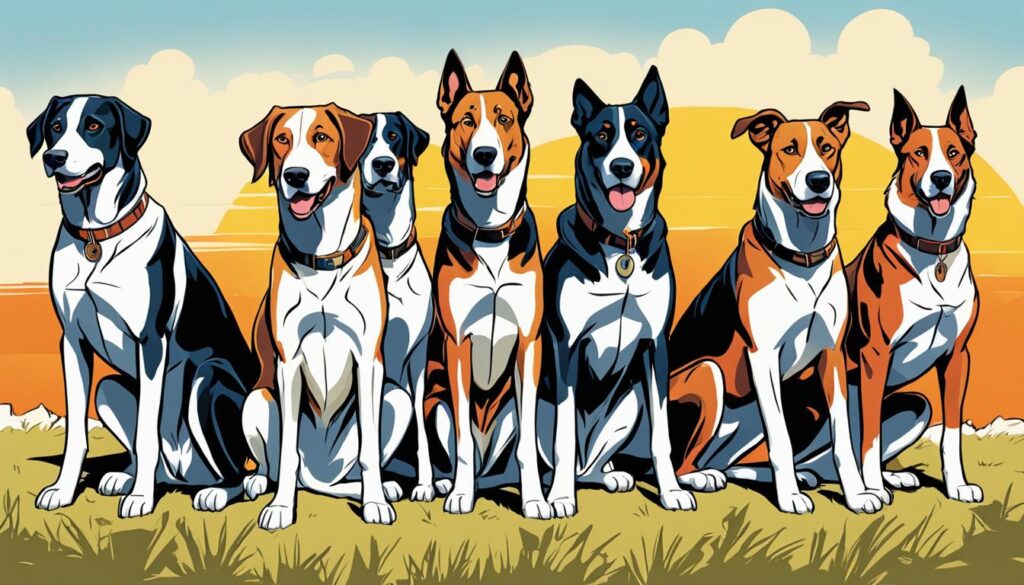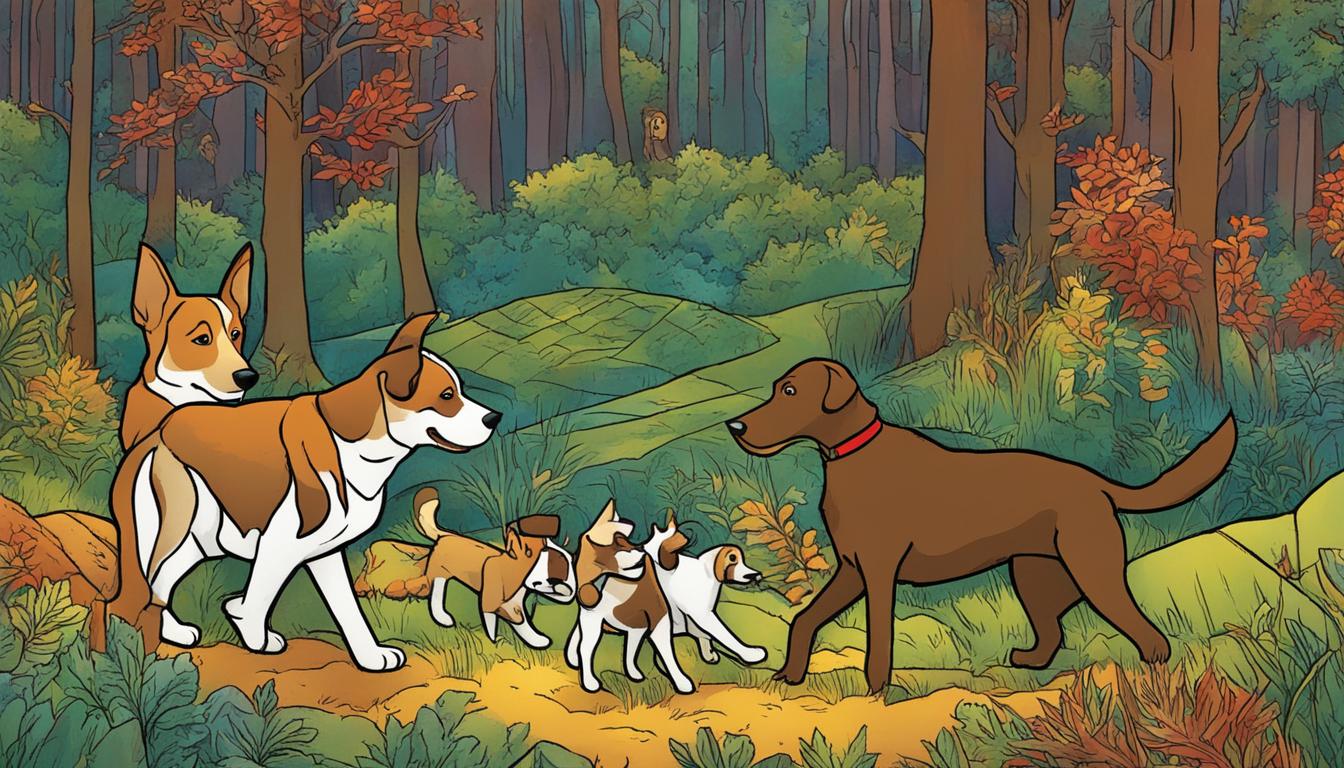Welcome to our book summary of “THE TRUTH ABOUT DOGS” by Stephen Budiansky, a captivating exploration of the canine world. This book offers comprehensive insights into various aspects of our furry friends, from their behavior and evolution to their intelligence and social nature. Throughout the pages, Budiansky sheds light on the truth about dogs, providing valuable knowledge for dog lovers everywhere.
In this summary, we will explore the fascinating world of dogs, examining the crucial aspects that define their existence and relationship with humans. Get ready to dive into the pages of “THE TRUTH ABOUT DOGS” and gain valuable insights into the canine world. Stay with us and keep reading for an enlightening experience.
Throughout the summary, we will delve deeper into Stephen Budiansky’s writing and provide info on the book’s key themes, highlighting its relevance to the contemporary understanding of our four-legged friends. Allow us to provide you with a glimpse into the captivating world of “THE TRUTH ABOUT DOGS” by Stephen Budiansky.
Understanding Canine Behavior
Dogs are beloved pets that have been human companions for thousands of years. Understanding their behavior is crucial to developing a deeper bond and ensuring a happy and healthy living environment. In his book “THE TRUTH ABOUT DOGS,” Stephen Budiansky offers insights into the innate instincts and behaviors that shape our furry friends’ actions.
Canine instincts drive many of a dog’s behaviors. They are born with certain tendencies that help them survive in the wild but can manifest in unusual ways in domesticated settings. For example, dogs have a natural instinct to hunt, which can lead them to chase after small animals or play rough with smaller dogs.
“Understanding your dog’s innate tendencies is key to effectively communicating with them and providing a happy living environment.”
Budiansky also dives into the role of environmental factors on dog behavior. A dog’s upbringing and experiences can shape their behaviors and emotional responses. Dogs that are socialized early in life tend to be more comfortable around other dogs and people and are less likely to develop aggressive tendencies.
Overall, understanding canine behavior involves a combination of recognizing natural instincts and understanding individual experiences. With this knowledge, dog owners can create a positive and healthy home environment for their furry friends.
Evolution of Dogs
The domestication of dogs is a fascinating subject that Budiansky explores in great detail. Dogs are believed to have evolved from wolves, with evidence suggesting that domestication took place approximately 15,000 years ago.
Through selective breeding, humans were able to manipulate the traits and characteristics of dogs, adapting them for specific purposes such as hunting, guarding, and companionship. Over time, the bond between humans and dogs grew stronger, leading to the diverse range of breeds we see today.
Despite this, some of the characteristics of wolves remain in domesticated dogs, such as their social hierarchy and pack mentality. This genetic connection is a powerful research tool, allowing scientists to delve deeper into the evolution and behavior of dogs.
“The similarities between wolves and dogs suggest that studying wolves can provide valuable insights into the evolution of dogs.”
Canine Intelligence
Budiansky’s “THE TRUTH ABOUT DOGS” offers valuable insight into the cognitive abilities of man’s best friend. Dogs possess an exceptional level of intelligence, which has been recognized and studied by experts around the world.
Research has shown that dogs have the cognitive ability to understand over 200 words. They also have the capacity to count up to five, as well as perform simple arithmetic. Their problem-solving abilities are also impressive, with the ability to navigate complex puzzles and find solutions to difficult challenges.
Furthermore, dogs possess the intelligence to interpret human body language and emotional cues. This has been observed in dogs used for therapy, as they can detect and respond to signals of stress, anxiety, and sadness in humans.
“The dog’s ability to perceive and interpret social cues, their emotional intelligence, and cognitive flexibility make them truly remarkable creatures.”
Budiansky’s exploration of canine intelligence provides fascinating insights into the mental prowess of dogs and their exceptional ability to coexist with humans.
Communication with Dogs
Effective communication is essential for building a strong relationship with your furry friend. Understanding your dog’s body language, vocalizations, and non-verbal cues is crucial for interpreting their needs and emotions. Dogs communicate in various ways, including:
- Body language: Dogs use their body to express themselves. A wagging tail usually signifies happiness, while a stiff posture indicates fear or aggression. By paying attention to the position of their ears, tail, and body, you can get a better understanding of their mood.
- Vocalizations: Barking, whining, growling, and howling are some of the ways dogs communicate through sound. Each type of vocalization signifies a different emotion or need.
- Non-verbal cues: Dogs use specific gestures to convey their intentions and desires, such as nudging your hand to signal they want attention, or lying flat on the ground to express submission.
By understanding how to interpret these signals, you can respond effectively and appropriately to your dog’s needs.

“Dogs have a language that is more complex and subtle than we often give them credit for and that can help us develop deeper relationships with them.”
Table: Common Dog Behaviors and What They Mean
| Behavior | Meaning |
|---|---|
| Tail wagging | Shows excitement or happiness, but can also indicate nervousness or anxiety depending on the speed and position of the tail. |
| Growling | Indicates aggression or fear. Do not punish your dog for growling as it is their way of communicating. |
| Paw lifting | Can signify playfulness, curiosity, or anxiety. Depending on the context, it could also indicate a willingness to shake hands or a request for attention. |
| Showing teeth | Usually a sign of aggression or fear. Avoid approaching a dog showing their teeth, and give them space. |
| Barking | Can mean many things depending on the tone and context, including alerting, warning, asking for attention, or expressing fear or aggression. |
Interpreting your dog’s behavior and responding appropriately can help build trust and strengthen your bond. By learning how to communicate effectively, you can create a happy and healthy relationship with your furry friend.
The Social Nature of Dogs
Dogs are known for their social behavior, and much of it stems from their innate pack mentality. Stephen Budiansky explains that dogs are descendants of wolves and have retained many of their ancestor’s social instincts. Within a pack, there is always a hierarchical structure, where certain individuals hold more power and status than others. Similarly, dogs also have a social hierarchy and establish their positions within a group through a combination of body language, vocalizations, and other cues.
One of the ways dogs establish their social status is through dominance displays, such as standing tall, growling, or even biting. Budiansky notes that these displays are not always aggressive, but rather a way for dogs to communicate their rank to others. In a group of dogs, the one with the highest status is often the one who eats first, initiates play, and receives the most attention from others.
How Dogs Form Relationships
While dogs do have a social hierarchy, they are also capable of forming close relationships with one another. This is particularly evident in dogs that have grown up together or have spent a lot of time playing and interacting with each other. In such cases, dogs often share toys, groom each other, and even sleep side by side. Budiansky explains that these social interactions are critical to a dog’s development and wellbeing.
“Long before we ever showed up on the scene, dogs had already established themselves as social animals with complex hierarchies and a need for companionship.”
However, not all dogs get along with each other, and some may exhibit aggressive behavior towards others. Budiansky suggests that this aggression is often the result of fear or anxiety rather than pure aggression. It is important for dog owners to understand their pet’s social needs and behavior to ensure that they are providing the necessary socialization opportunities.
The Impact of Human Interaction
While dogs are highly social animals that thrive on interaction with other dogs, they also have an incredible capacity for bonding with humans. Budiansky suggests that dogs’ social and emotional intelligence make them particularly adept at forming meaningful connections with people. Dogs are known for their loyalty, affection, and ability to sense our emotions, which can make them incredible companions.
| Dog Social Behavior | Pack Mentality |
|---|---|
| Establishing social hierarchy through dominance displays | Social behavior shaped by ancestral pack mentality |
| Forming close relationships through shared experiences | Aggressive behavior often rooted in fear and anxiety |
| Thriving on interaction with other dogs | Incredible capacity for bonding with humans |
The History of Dog Breeds
The diversity and uniqueness of dog breeds is a testament to their rich history and purposeful development of specific traits and characteristics. From their origins as wolves to their current domestication, dogs have been bred for a variety of purposes, including hunting, herding, guarding, and companionship.
Different regions of the world have contributed to the development of various breeds, resulting in a wide range of physical and behavioral characteristics. For example, the Bulldog was originally bred in England for bull-baiting, while the Border Collie was developed in Scotland for herding.
With the rise of dog shows in the 19th century, breed standards were established to promote uniformity and predictability in appearance and temperament. Today, there are hundreds of recognized dog breeds, each with their own unique history and characteristics.

The creation of new dog breeds continues to this day, with breeders working to develop breeds for specific purposes or to combine desirable traits from different breeds. However, it is important to note that this process should always prioritize the health and well-being of the dogs, rather than solely focusing on appearance or other superficial qualities.
Top 10 Most Popular Dog Breeds in the US (2020)
| Breed | Rank |
|---|---|
| Labrador Retriever | 1 |
| French Bulldog | 2 |
| German Shepherd | 3 |
| Golden Retriever | 4 |
| Bulldog | 5 |
| Poodle | 6 |
| Beagle | 7 |
| Rottweiler | 8 |
| German Shorthaired Pointer | 9 |
| Dachshund | 10 |
Sources: American Kennel Club, https://www.akc.org/
The Canine-Human Bond
It’s no secret that dogs have a special place in our hearts. Our furry friends have been our companions for thousands of years, and the bond between humans and dogs continues to be one of the most beautiful relationships in nature. The human-dog relationship is built on a foundation of love, trust, and loyalty, and it’s no wonder that dogs are often called “man’s best friend.”
But what creates such a strong emotional connection between dogs and humans? Research has shown that the bond is supported by a range of factors, from shared experiences to physical touch. One study found that dogs and their owners experience a surge of “love hormone” oxytocin when they gaze into each other’s eyes, leading to feelings of affection and attachment.
The emotional connection between dogs and humans is also supported by the dog’s ability to read human body language and emotional cues. Dogs can pick up on subtle changes in our tone of voice, facial expressions, and body language, which allows them to respond in a way that supports our emotional needs. This creates a sense of mutual understanding and communication, which can strengthen the bond between human and dog.
Through shared experiences, physical touch, and emotional communication, the bond between humans and dogs is a testament to the power of love and connection in our lives. Whether it’s curling up on the couch with our furry friends or taking them for a walk in the park, the human-dog relationship is a source of joy and comfort that enriches our lives in countless ways.
Conclusion
“THE TRUTH ABOUT DOGS” by Stephen Budiansky is a powerful reminder of the wonder and complexity of the canine world. Whether you’re a seasoned dog owner or new to the world of dogs, this book summary offers valuable insights into their behavior, evolution, intelligence, communication, social nature, breed history, and the deep bond they share with humans.
Budiansky’s exploration of the canine world is both informative and captivating, providing a window into the fascinating lives of our furry companions. From their instincts and behaviors to their incredible cognitive abilities and social dynamics, “THE TRUTH ABOUT DOGS” is a must-read for anyone who loves dogs.
This book is a celebration of all things canine, shedding light on the many remarkable traits and characteristics that make dogs such special and beloved members of our families. So, if you’re ready to gain a deeper understanding of the world of dogs, pick up a copy of “THE TRUTH ABOUT DOGS” by Stephen Budiansky today.



